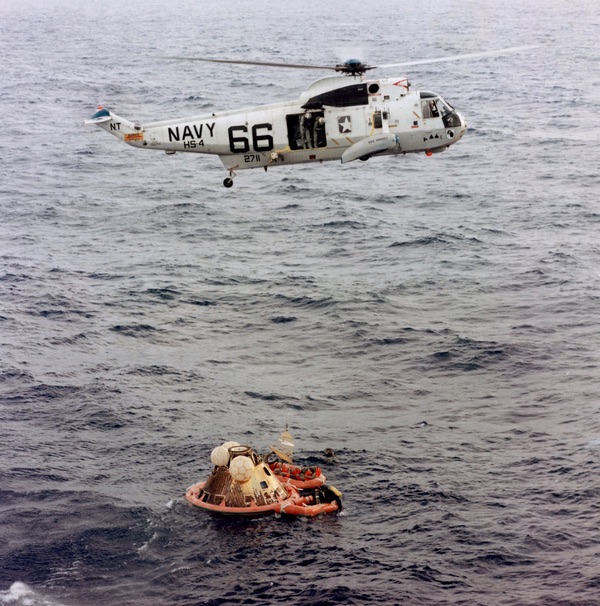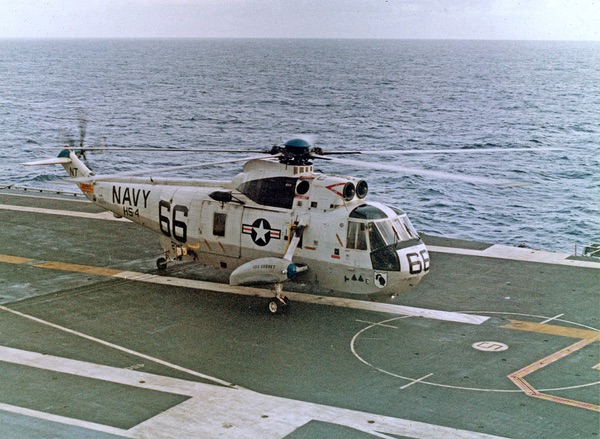
Apollo RevisitedThe big white bird: the flights of Helo 66by Dwayne A. Day
|
| Helo 66 was lost at sea in a tragic accident in the 1970s. Today there are Sea Kings painted to resemble it in several museums. |
If you head about 800 kilometers to the northwest, to Pier Three at the former Alameda Naval Air Station and go aboard the USS Hornet Museum, on her aft flight deck you will see another Sea King, also painted with a large “66” on the side of her fuselage. The Sea King on display on the Hornet was used in the movie Apollo 13, which is why it retains its markings from the helicopter carrier Iwo Jima, which was the recovery ship for that mission. The helicopter was obtained from the Navy and restored off-site before being hoisted aboard the Hornet. The museum has several other helicopters that are painted like the recovery aircraft for the American space program, including a Piesecki HUP-25 Retriever of the type used to ferry John Glenn from the USS Noa to the carrier USS Randolph following his Friendship 7 orbital flight in 1962, and a UH-34 Seahorse of the type used for the Gemini and Apollo recoveries.
The real Helo 66, the one in the Apollo 11 documentary and all of those famous Apollo era photographs, crashed into the ocean off the coast of San Diego in 1975. That helicopter, BuNo 152711, was lost in a tragic accident during training to hunt Soviet submarines.
 Helo 66 was used to recover several Apollo missions, including Apollo 11. (credit: NASA) |
Starting in late 1968, the “Black Knights” of Navy Helicopter Anti-Submarine Squadron Four (HS-4) began training for recovering Apollo spacecraft. Over the next couple of years HS-4 was involved in the recovery efforts for Apollo missions 8, 10, 11, 12, and 13, flying off the USS Hornet, as well as other ships. It is the silhouettes of those capsules that are painted on both Helo 66 replicas on the Midway and the Hornet. The members of HS-4 received the Navy’s Meritorious Unit Commendation ribbon for their Apollo role.
| According to a former Sea King pilot, it was notoriously easy to accidentally back the Sea King into the water while in a hover, especially at night. |
But Helo 66 did not always fly with that distinctive number. After it had already made several Apollo recoveries, the Navy switched to a three-number squadron designator and so helicopter number 66 became number 740. But before each recovery effort, the squadron repainted “66” on the side of the aircraft. After Apollo 13, the Navy began using other aircraft for the Apollo recoveries. Helo 66, or by now number 740, was still a relatively new and frontline aircraft, and so it returned to performing HS-4’s primary mission of hunting submarines.
In the summer of 1975, Lieutenant Leo S. Rolek, copilot Lieutenant (Junior Grade) Charles D. Neville, and two crewmen took off in the early evening from the Naval Auxiliary Air Field at Imperial Beach, California. They were on an anti-submarine sonar training flight and Rolek flew the helicopter out to a designated training area off the coast from San Diego. They began operations, which involved making approaches to a specified location and dipping their sonar into the water. The Sea King’s sonar lowered through a large hole in the helicopter’s fuselage and when it entered the water it opened up like the spokes of an umbrella and extended its sensors.
The crew reported back to base every half hour that everything was going fine until about 9:30. The helicopter lowered its sonar to about 30 meters below the water’s surface when the aircraft became unstable, apparently because of the sonar being dragged in the water and pulling the helicopter. The sonar operator lowered the sonar deeper, hoping that this would improve stability, but that did not happen.
According to reports, the helicopter was “pulled” into the ocean. It impacted the water, broke up, and began to sink. Just how it broke up is unclear—helicopters are at the mercy of their spinning rotor blades. One possibility is that the tail rotor struck the surface and disintegrated, causing the helicopter to spin out of control and crash. Because the heaviest part of a helicopter is the engines and transmission mounted over the cabin, most helicopters immediately tip over when they hit the water and crews are trained to exit a sinking upside-down helicopter. The amazing thing is that all four men managed to escape the helicopter. They were picked up by a Coast Guard HH-3F helicopter just before midnight and were taken to the Naval Hospital in San Diego. Sadly, pilot Leo Rolek suffered a ruptured spleen and died of his injuries three weeks later.
Exactly how the accident happened remains unclear from the heavily censored official accident report. Unfortunately, overly zealous Navy censors deleted substantial parts of the report, making it difficult to determine what happened and why—all it says is that “aircraft impacted water in rearward flight from hover at 40 feet.” The censors even deleted the names of the four men aboard the helicopter, despite the fact that they have been known for decades. But according to a former Sea King pilot, it was notoriously easy to accidentally back the Sea King into the water while in a hover, especially at night.
| Next to the equipment still left on the lunar surface, Helo 66 is the most famous piece of hardware associated with the Apollo program currently not preserved and on display in a museum. |
It might still be possible to someday recover some of the wreckage of Helo 66 if it is located off the southern California coast. Several billionaires have demonstrated an interest and capability for deep sea exploration. Amazon CEO Jeff Bezos sponsored a series of expeditions between 2010 and 2013 to find and raise the F-1 engines from several Apollo missions that were on the bottom of the Atlantic Ocean. Microsoft’s co-founder Paul Allen, who died in 2018, sponsored expeditions that have found numerous famous US Navy ships, including the wreck of the US Navy cruiser USS Indianapolis on the bottom of the Pacific as well as the carriers Wasp and Hornet (the predecessor to the current museum ship in Alameda). It should not be difficult for a privately funded expedition to locate and raise Helo 66. There is precedent: in 1999 an expedition funded by the Discovery Channel and led by Curtis Newport located and raised Liberty Bell 7.
 Helo 66 was used to recover several Apollo missions, including Apollo 11. (credit: US Navy) |
There are legal challenges: the US Navy still owns the helicopter and would not cede ownership. But Newport successfully negotiated with NASA, and Bezos also navigated the legal issues over the F-1 engines. The US Navy is a different bureaucracy, but the people interested in doing these searches are not doing so to own what they find, but to preserve what they find, so having the Navy take ownership of the recovered Helo 66 should not be an impediment to the people likely to fund such an operation.
Next to the equipment still left on the lunar surface, Helo 66 is the most famous piece of hardware associated with the Apollo program currently not preserved and on display in a museum. If it is recovered it is unlikely to end up on one of the aircraft carrier museums, but it could rightfully take its place in the Smithsonian. First, somebody has to find it.
Apollo 8
Recovered 27 December 1968
Pilot: Commander Donald S. Jones
USS Yorktown, CVS-10
Apollo 10
Recovered 29 May 1969
Pilot: Commander Chuck B. Smiley
USS Princeton, LPH-5
Apollo 11
Recovered 24 July 1969
Pilot: Commander Donald S. Jones
USS Hornet, CVS-12
Apollo 12
Recovered 24 November 1969
Pilot: Commander Warren E. Aut
USS Hornet, CVS-12
Apollo 13
Recovered 17 April 1970
Pilot: Commander Chuck B. Smiley
USS Iwo Jima, LPH-2
Note: we are temporarily moderating all comments subcommitted to deal with a surge in spam.